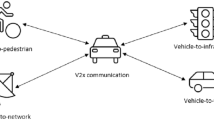Abstract
Vehicular ad hoc networks (VANETs) consist of vehicles with high mobility that broadcasts delay-intolerant safety and informative messages frequently. The real identity of a vehicle needs to be kept private as these vehicles operate in an open and insecure network. A receiving vehicle must also authenticate the received messages before accepting or rejecting it. Additionally, the original identity of an authenticated vehicle must be discovered if it tries to obstruct the normal functioning of the network by transmitting the wrong messages. In this paper, a lightweight ring signature-based conditional privacy-preserving authentication (RCPPA) scheme is proposed to address the security issues in VANETs. In the proposed scheme, a vehicle gets a pseudonym from root trusted authority (RTA). If a vehicle performs a malicious action, then only RTA can reveal the original identity of the vehicle. A vehicle produces a ring signature to sign a message. Vehicles within the communication range verify this signature to ensure that the message is sent from an authenticated vehicle. Ring signature provides unconditional privacy to vehicles, but a pseudonym that is sent in the message is used by the RTA to reveal the real identity. The biggest advantage of this scheme is that it allows only authenticated vehicles to generate a ring signature and not any intruder without requiring any cooperation from any other vehicle. The results of the simulation show that the RCPPA scheme using a ring signature and pseudonym provides not only vehicle and message authentication but also non-repudiation through conditional privacy-preservation.







Similar content being viewed by others
References
Sakiz, F., & Sen, S. (2017). A survey of attacks and detection mechanisms on intelligent transportation systems: VANETs and IoV. Ad Hoc Networks, 61, 33–50.
Xu, Q., Mak, T., Ko, J., & Sengupta, R. (2004). Vehicle-to-vehicle safety messaging in dsrc. In Proceedings of the 1st ACM international workshop on Vehicular ad hoc networks (pp. 19–28). ACM.
Aloqaily, M., Kantarci, B., & Mouftah, H. T. (2016). Multiagent/multiobjective interaction game system for service provisioning in vehicular cloud. IEEE Access, 4, 3153–3168.
Talat, H., Nomani, T., Mohsin, M., & Sattar, S. (2019). A survey on location privacy techniques deployed in vehicular networks. In 2019 16th International Bhurban conference on applied sciences and technology (IBCAST) (pp. 604–613). IEEE
Aloqaily, M., Otoum, S., Al Ridhawi, I., & Jararweh, Y. (2019). An intrusion detection system for connected vehicles in smart cities. Ad Hoc Networks, 90, 101842.
Otoum, S., Kantarci, B., & Mouftah, H. T. (2017). Detection of known and unknown intrusive sensor behavior in critical applications. IEEE Sensors Letters, 1(5), 1–4.
Kiltz, E., & Pietrzak, K. (2010). Leakage resilient elgamal encryption. In International conference on the theory and application of cryptology and information security (pp. 595–612). New York: Springer.
Jain, R., & Kashyap, I. (2019). An qos aware link defined olsr (ld-olsr) routing protocol for manets. Wireless Personal Communications, 108(3), 1745–58.
Xie, Y., Wu, L., Zhang, Y., & Shen, J. (2016). Efficient and secure authentication scheme with conditional privacy-preserving for vanets. Chinese Journal of Electronics, 25(5), 950–956.
Rajput, U., Abbas, F., Eun, H., & Oh, H. (2017). A hybrid approach for efficient privacy-preserving authentication in vanet. IEEE Access, 5, 12014–12030.
Al Ridhawi, I., Aloqaily, M., Kotb, Y., Jararweh, Y., & Baker, T. (2019). A profitable and energy-efficient cooperative fog solution for iot services. IEEE Transactions on Industrial Informatics, 16(5), 3578–86.
Otoum, S., Kantarci, B., & Mouftah, H. T. (2019). On the feasibility of deep learning in sensor network intrusion detection. IEEE Networking Letters, 1(2), 68–71.
Lai, Y., Xu, Y., Yang, F., Lu, W., & Yu, Q. (2019). Privacy-aware query processing in vehicular ad-hoc networks. Ad Hoc Networks, 91, 101876.
Raya, M., & Hubaux, J.-P. (2007). Securing vehicular ad hoc networks. Journal of Computer Security, 15(1), 39–68.
Ali, I., Hassan, A., & Li, F. (2019). Authentication and privacy schemes for vehicular ad hoc networks (vanets): A survey. Vehicular Communications, 16, 45–61. https://doi.org/10.1016/j.vehcom.2019.02.002.
Azees, M., Vijayakumar, P., & Deboarh, L. J. (2017). EAAP: Efficient anonymous authentication with conditional privacy-preserving scheme for vehicular ad hoc networks. IEEE Transactions on Intelligent Transportation Systems, 18(9), 2467–2476.
Michael, E. N., & Henry, L. O. (2010). Scalable certificate revocation list distribution in vehicular ad hoc networks. In 2010 IEEE Globecom Workshops (pp. 54–58). IEEE.
Cui, J., Zhang, J., Zhong, H., & Xu, Y. (2017). Spacf: A secure privacy-preserving authentication scheme for vanet with cuckoo filter. IEEE Transactions on Vehicular Technology, 66(11), 10283–10295.
Zhang, L., Wu, Q., Domingo-Ferrer, J., Qin, B., & Hu, C. (2017). Distributed aggregate privacy-preserving authentication in vanets. IEEE, 18(3), 516–526.
Lim, K., Tuladhar, K. M., Wang, X., & Liu, W. (2017). A scalable and secure key distribution scheme for group signature based authentication in vanet. In 2017 IEEE 8th annual ubiquitous computing, electronics and mobile communication conference (UEMCON) (pp. 478–483). IEEE, 2017.
Sugumar, R., Rengarajan, A., & Jayakumar, C. (2018). Trust based authentication technique for cluster based vehicular ad hoc networks (vanet). Wireless Networks, 24(2), 373–382.
Aljallad, S., Al-Qassas, R. S., & Qasaimeh, M. (2017). A group leader location hiding technique for vanets. International Journal of Distributed Systems and Technologies (IJDST), 8(3), 67–80.
Zhong, H., Han, S., Cui, J., Zhang, J., & Xu, Y. (2019). Privacy-preserving authentication scheme with full aggregation in vanet. Information Sciences, 476, 211–221.
Ali, I., & Li, F. (2020). An efficient conditional privacy-preserving authentication scheme for vehicle-to-infrastructure communication in vanets. Vehicular Communications, 22, 100228.
Vijayakumar, P., Chang, V., Deborah, L. J., Balusamy, B., & Shynu, P. (2018). Computationally efficient privacy preserving anonymous mutual and batch authentication schemes for vehicular ad hoc networks. Future Generation Computer Systems, 78, 943–955.
Ming, Y., & Cheng, H. (2019). Efficient certificateless conditional privacy-preserving authentication scheme in vanets. Mobile Information Systems. https://doi.org/10.1155/2019/7593138.
Cui, Y., Cao, L., Zhang, X., & Zeng, G. (2017). Ring signature based on lattice and vanet privacy preservation. Chinese Journal of Computation, 40(169), 1–14.
Liu, J., Yu, Y., Jia, J., Wang, S., Fan, P., Wang, H., et al. (2019). Lattice-based double-authentication-preventing ring signature for security and privacy in vehicular ad-hoc networks. Tsinghua Science and Technology, 24(5), 575–584.
Helfrich, B. (1985). Algorithms to construct minkowski reduced and hermite reduced lattice bases. Theoretical Computer Science, 41, 125–139.
Ajtai, M. (1996). Generating hard instances of lattice problems. In Proceedings of the twenty-eighth annual ACM symposium on theory of computing, (pp. 99–108). ACM.
Peikert, C., & Rosen, A. (2006). Efficient collision-resistant hashing from worst-case assumptions on cyclic lattices. In Theory of Cryptography Conference, (pp. 145–166). Springer
Regev, O. (2009). On lattices, learning with errors, random linear codes, and cryptography. Journal of the ACM (JACM), 56(6), 34.
Lyubashevsky, V., Peikert, C., & Regev, O. (2010). On ideal lattices and learning with errors over rings. In Annual international conference on the theory and applications of cryptographic techniques, (pp. 1–23). Springer.
Alkim, E., Ducas, L., Pöppelmann, T., & Schwabe, P. (2016). Post-quantum key exchange—a new hope. In 25th\(\{USENIX\}\)Security Symposium (\(\{USENIX\}\)Security 16) (pp. 327–343).
Wang, Y., Zhong, H., Xu, Y., & Cui, J. (2016). Ecpb: Efficient conditional privacy-preserving authentication scheme supporting batch verification for vanets. IJ Network Security, 18(2), 374–382.
Funding
None.
Author information
Authors and Affiliations
Corresponding author
Ethics declarations
Conflicts of interest
The authors declare that he/she has no conflict of interest.
Ethical approval
This article does not contain any studies with human participants or animals performed by any of the authors.
Additional information
Publisher's Note
Springer Nature remains neutral with regard to jurisdictional claims in published maps and institutional affiliations.
Rights and permissions
About this article
Cite this article
Mundhe, P., Yadav, V.K., Singh, A. et al. Ring Signature-Based Conditional Privacy-Preserving Authentication in VANETs. Wireless Pers Commun 114, 853–881 (2020). https://doi.org/10.1007/s11277-020-07396-x
Published:
Issue Date:
DOI: https://doi.org/10.1007/s11277-020-07396-x




